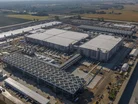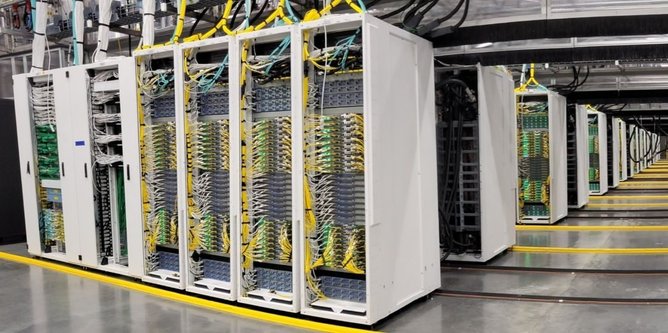Microsoft: Building the World’s Most Powerful AI Data Centre
-
Published Time: 2025-09-24T09:30:15Z
Article
Technology
Microsoft: Building the World’s Most Powerful AI Data Centre
September 24, 2025
5 mins
Share

Microsoft's Fairwater facility is due to go live in early 2026 (Credit: Microsoft)
Microsoft invests US$7bn in Wisconsin to launch a massive AI data centre by 2026, with a focus on sustainability, innovation and community development
Company portals
Microsoft
NVIDIA
Tags
MicrosoftAIHPCSustainabilityEnergyWisconsinUSHyperscaleData CenterData Centre
In Mount Pleasant, Wisconsin, Microsoft is spearheading the development of Fairwater, envisioned to become the world’s most powerful AI data centre.
Scheduled for completion in early 2026, this cutting-edge facility is part of a US$3.3bn investment.
Microsoft is already recruiting full-time staff for managing the site post-launch, underscoring its commitment to AI-driven projects.
In addition, the company has committed another US$4bn for a second data centre, marking a substantial US$7bn investment in Wisconsin.

High density cluster of AI infrastructure servers in a Microsoft data centre (Credit: Microsoft)
Designed for AI excellence
The Mount Pleasant facility is laser-focused on training frontier AI models. It will house hundreds of thousands of NvidiaGPUs in clustered formations.
These GPUs facilitate rapid AI model training through parallel processing. The facility boasts fibre optic connectivity capable of encircling the globe four times, delivering tenfold the performance of current leading supercomputers.
Aerial view of part of the closed loop liquid cooling system at Fairwater (Credit: Microsoft)
This site is pivotal for researchers and engineers, offering a platform to train next-gen models and experiment with innovative ideas efficiently. Microsoft's strategic vision positions the data center as a nucleus for breakthroughs in medicine and science, with AI workloads trained in Wisconsin playing a key role.
Moreover, the local community stands to benefit through job creation, long-term IT careers and training linked to the facility. A collaboration with Gateway Technical College has led to the establishment of Wisconsin's first ‘Datacenter Academy’, aimed at equipping students for data centre roles.
AI-powered sustainability
Commitment to sustainability is a primary focus for the project. A closed-loop liquid cooling system, representing over 90% of the facility's design, will drastically reduce water usage.
Microsoft ensures that the facility uses external air cooling, resorting to water only during peak heat periods, with consumption comparable to a single restaurant annually or an 18-hole golf course weekly during summer.
Microsoft is ensuring energy demands do not inflate local prices by pre-paying for energy and infrastructure consumption. This approach maintains price stability for residents.
The company pledges to offset every kilowatt hour of fossil fuel energy with equivalent carbon-free energy, supplemented by a 250MW solar project in Portage County.
Significant efforts are also underway in ecological restoration across Racine and Kenosha counties, reinforcing Microsoft's commitment to environmental impact.
Noelle Walsh, President, Microsoft Cloud Operations & Innovation (also featured in our Top 100 Women in Data Centres 2025)
“What sets Microsoft’s infrastructure apart is therelentless pursuit of innovation and sustainability,” says Noelle Walsh, President for Cloud Operations and Innovation at Microsoft, writing on LinkedIn.
“Our data centres use advanced closed-loop liquid cooling systems – integrated pipes circulate cold liquid directly into servers, extracting heat efficiently and ensuring zero water waste."
She continues: “Nearly 90% of our data centre capacity uses this system, requiring water only once during construction and continually reusing it with no evaporation losses. This breakthrough enables higher rack density and supports the most demanding AI workloads, while dramatically reducing environmental impact.
“Globally, Microsoft has contracted over 34 gigawatts (GW) of carbon-free (renewable) electricity across 24 countries. In Wisconsin, we will match our energy consumption with renewable energy onto the grid.
“To protect customers from future cost increases due to data centre operations, Microsoft is pre-paying for the energy and electrical infrastructure used by the Wisconsin data centre."
Aerial view of a dedicated storage and compute data centre used to store and process data for the AI data centre (Credit: Microsoft)
Infrastructure and community commitment
During peak construction, more than 3,000 workers from various trades will be employed, including electricians, plumbers, and concrete specialists.
Once operational, the first data centre will employ about 500 full-time staff, expanding to 800 with the second site's completion.
Microsoft's educational investments through the Datacenter Academy are planned to train over 1,000 students in five years.
With partners like the University of Wisconsin and others, Microsoft has trained 114,000 individuals in AI skills statewide, including 1,400 from Racine County.
Innovations extend to broadband, enhancing accessibility for over 9,300 rural residents and connecting 1,200 homes and businesses in Sturtevant.
Microsoft’s Vice Chair and President, Brad Smith (Credit: Microsoft)
“As someone who spent almost five years as a kid going to school and delivering the morning newspaper by bicycle in Mount Pleasant, this moment means more than just personal nostalgia,” he says.
“It shows that Wisconsin has not just a longstanding and proud industrial past – it’s helping define the future of American innovation.
“Mount Pleasant isn’t just becoming a hub for AI – it’s becoming a blueprint for how innovation can serve everyone. We’re not just investing in an AI data centre; we are investing in a community.
"And we are investing in apowerful idea: that innovation is for everyone, and that we can build the future together – with care for people, place and planet.”
Company Portals
Microsoft
NVIDIA






Related Content




